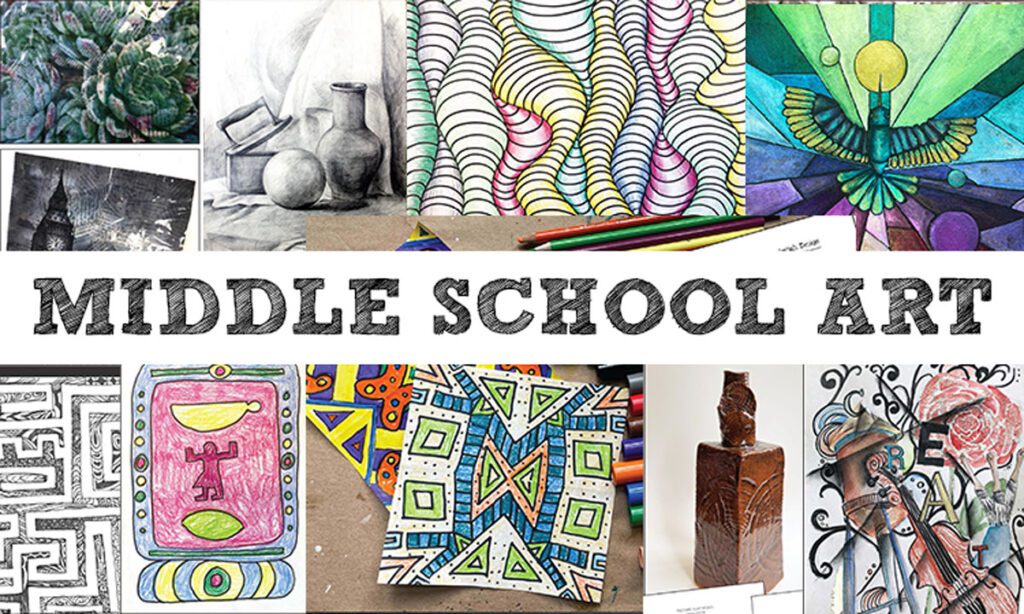
I have designed many art curriculums in my time teaching and developing art lessons. Middle school can be a tough level to plan for. When developing a middle school curriculum you need to build off of techniques taught in elementary art classes and prepare them for high school art classes. You also have to take into account the possibility they didn’t have art in elementary school. Topics must be engaging, not too juvenile, but age-appropriate.
When creating middle school art curriculums, similar to elementary art curriculums, I use the elements of art and principles of design as the backbone. Because the elements and principles are often introduced in elementary art, in middle school art classes you want to review and reinforce the ideas they learned in elementary school.
Check out how I introduce each element of art and principle of design when creating a middle school art curriculum. There is a lot of info here, it’s going to be a long one! If you want to jump straight to the details, check out my year-long middle school art curriculum (on TPT here and on my website here), semester 1 middle school art curriculum (on TPT here and on my website here), and semester 2 middle school art curriculum (on TPT here and on my website here).
CONTRAST

When designing an elementary art curriculum I prefer teaching the elements and principles in order of complexity. But, because middle school is a review, with middle school art curriculums you can jump around. Focus on building art techniques and subjects from simple to complex. Next, highlight the element or principle that is most important in the project.
In my middle school art curriculum, I like to start with a still-life drawing. Students draw a still life with little instruction, then redraw it at the end of the course to gauge their improvement. This is a homerun lesson for administrators, who love those tangible growth markers. It also gives students a boost to see how far they have come. I focus on the principle of design, contrast in this lesson. (Check out this lesson on my TPT or my website shop).
VALUE
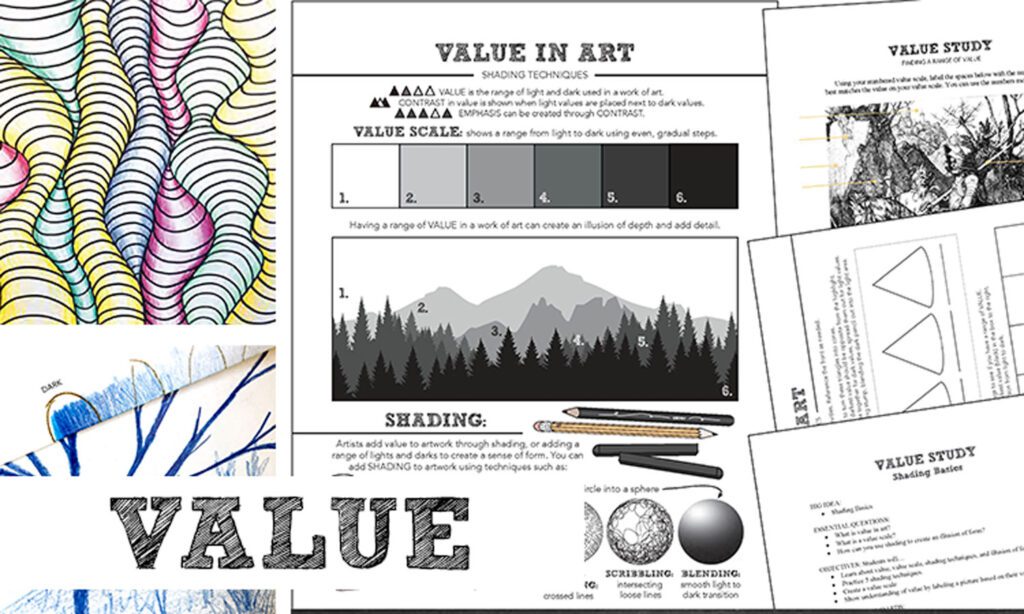
After the still life drawing we shift focus to the element of art, value, with a shading review (check it out on my TPT). I use printable art activities for students to work on independently before applying shading techniques to a fun optical illusion project, op art squiggles (check it out on my TPT). This is a fun, approachable way to review shading techniques. Op art squiggles ix one of those projects that is successful no matter a student’s art ability.
Value continues to be the highlighted element of art in the next project, landscape drawing. Atmospheric perspective (check it out on my TPT) is discussed and students focus on monochromatic landscapes. Through shading practice, a fun op art lesson, and a traditional drawing, middle schoolers practice and master techniques.
VARIETY

Next in my middle school art curriculum is a focus on variety. After a traditional, technique-focused project with the landscape drawing, students loosen up with Zentangles (check it out on my TPT here). Students design a zendoodle maze and fill their design with patterns. Variety is the highlighted principle of design in this fun, loose project. I love this lesson because it has a cross-curricular tie into ELA by discussing the book, The Maze Runner (another admin homerun).
EMPHASIS
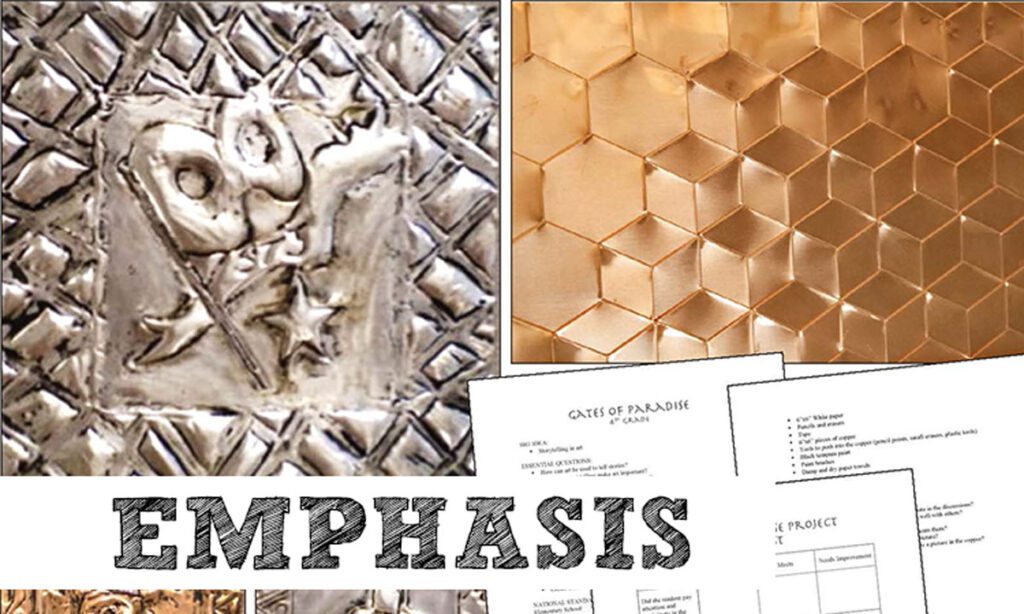
After so much drawing focus it’s time to add a new material and technique, copper tooling! This is a lesser-known art material, but it’s so fun to work with. Your middle school art students will be oooohhhing and aaaaahhhhing over the shiny metallic surfaces. The bonus, copper sheets are cheap, double-sided (silver on one, copper on the other), and you can use pencils to create the design. For this project, students look at historic bronze reliefs and create their own story in one image. The principle of design, emphasis, is the highlight as students learn how to emphasize their focal points. (Check out this project on my TPT).
SHAPE
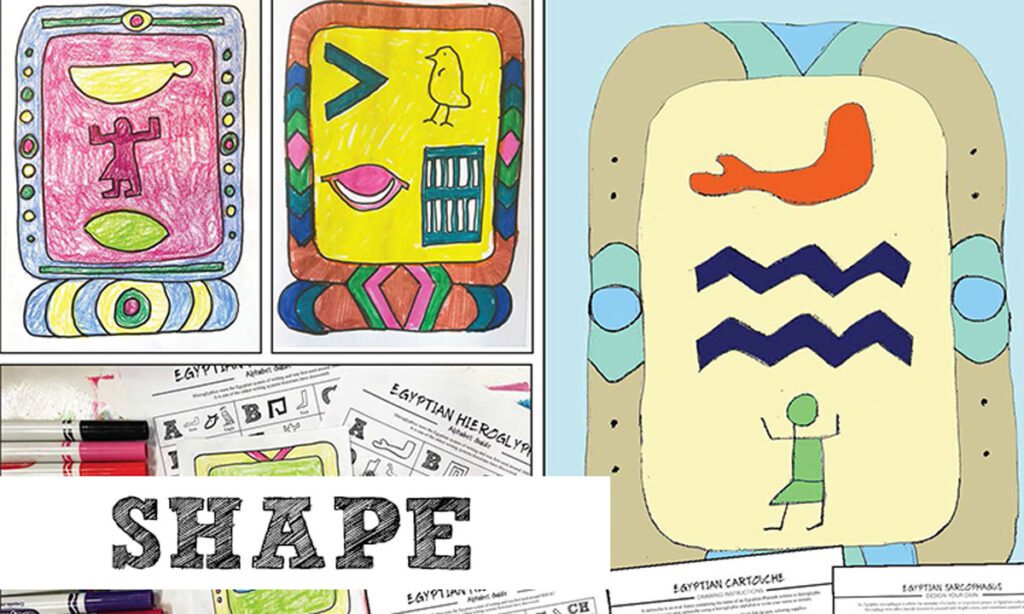
Art history is an underlying theme in the next project, a focus on Egyptian cartouches. Although students return to drawing materials, they finally get to incorporate a wider range of color. This project is low supply, using colored pencils, crayons, or markers. Students write their name or initials in Egyptian hieroglyphics and use the element of art, shape, as a guide in adding decoration. (Check this out on my TPT)
REPETITION AND PATTERN
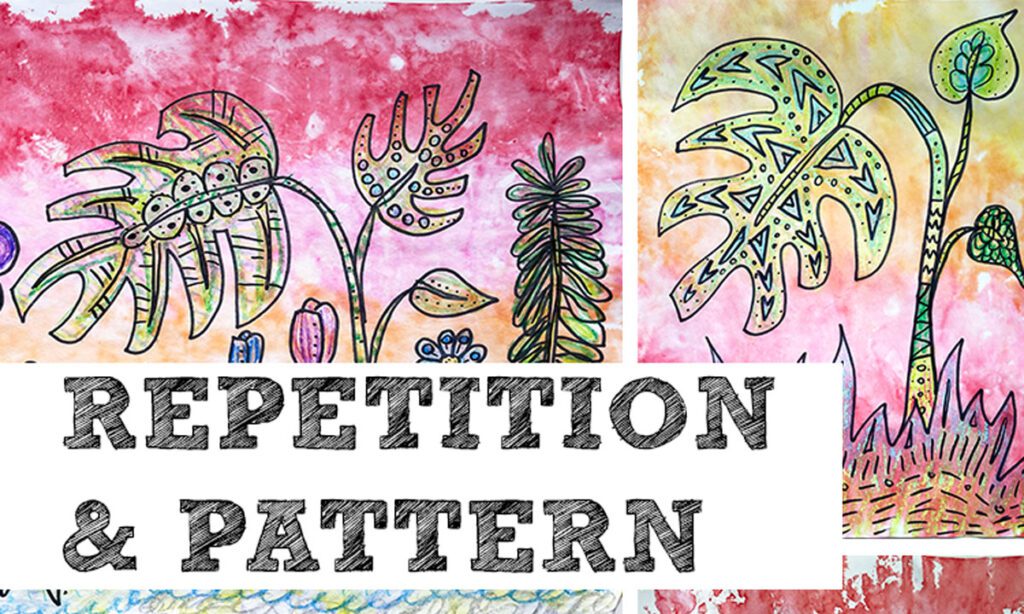
Since you can’t have pattern without repetition I like to teach these two principles of design together. Middle school artists continue to work in color using markers to create a print. First, they draw a garden design using Sharpie, filling the shapes with patterns. Next, marker is transferred from foil to their drawing to create a unique look. (Check this out on my TPT)
COLOR
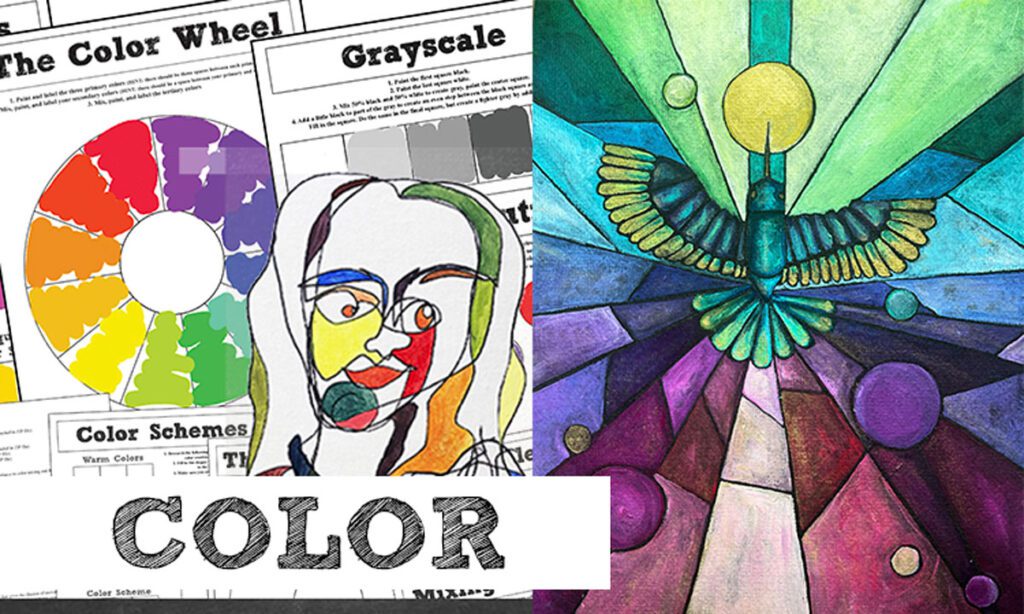
Although students have used color up to this point, this unit is where color is emphasized and discussed in depth! I start my middle school art students with a color review. We look at color theory, color schemes, and similar. Students work on color mixing handouts to review color mixing and the color wheel. (Check out the handouts on my website).
Following a color review students apply their understanding of color mixing in a fun portrait project. Rather than focusing on realistic portraits, students create two blind contours, a self-portrait and a portrait of their neighbor. These drawings create such fun shapes and spaces they fill with color. (Check out this lesson on my TPT).
Next in my middle school art curriculum is the final painting project, a roofing paper painting. This focuses on symbolism and selecting a color scheme. Students create stained glass-inspired paintings that have a big visual impact. You can read about this project in-depth on my blog or grab it ready to go on my TPT or on my website shop.
RHYTHM
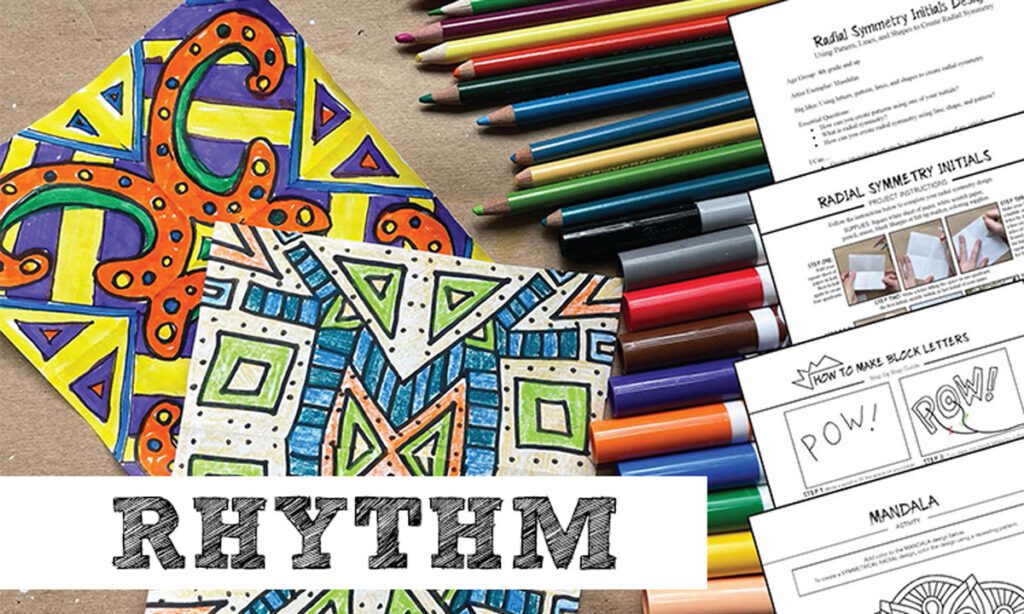
Rhythm is the next principle of design students focus on. For this art lesson students use their initials to create a mandala design. Using repetition and pattern they create a sense of rhythm around a central point to create radial symmetry. This is another quick, low-supply project. Check it out on my TPT.
SPACE
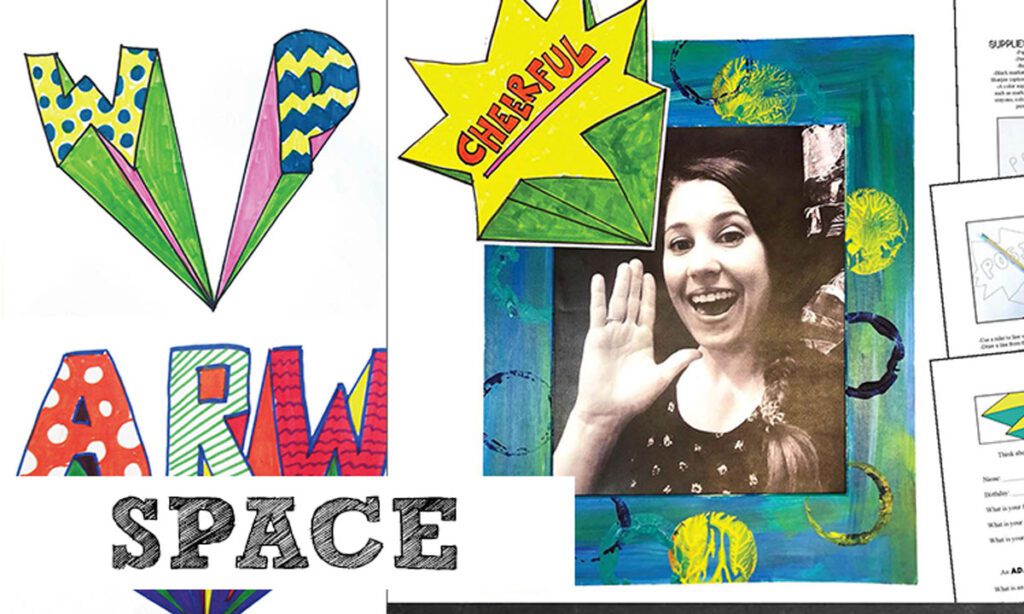
The element of art, space, is the subject of two projects because it can be technically challenging. To warm up, students learn about one-point perspective by drawing their name or initials in perspective (check it out on my TPT). Next, students apply their understanding of one-point perspective to create a mixed media project incorporating perspective and self-reflection. They select a word that reflects them and add it to a perspective word bubble. Next, they take a picture of themselves showing that word. To wrap it up, they design a frame to put their picture in and place the word on top (Check it out on my TPT).
PROPORTION & SCALE
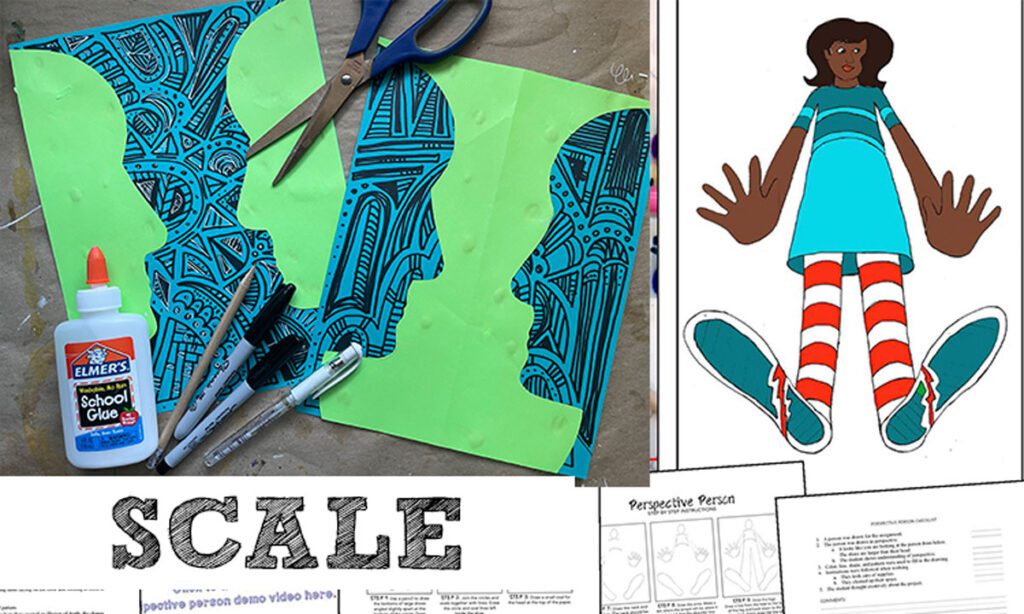
A perfect building-off point from space is scale. Students think of scale two-dimensionally by creating another Op Art project, a face/vase design. This is filled in with more Zentangles, continuing to practice lines and patterns. Check out this lesson on my TPT. Next, they think of scale in terms of creating an illusion of space by drawing a person in perspective. Check out this lesson on my TPT.
LINE

Line is the focus of the self-portrait print project. This project is so fun because students focus on creating a Pop Art version of themselves. To make this printing project even easier, have students print in white and add color using colored pencils. Scratch foam is the material used to print, this is a cheap, easy-to-use product. The lines are created in the printing process and create a unique, interesting work of art. Check this project out on my TPT.
FORM
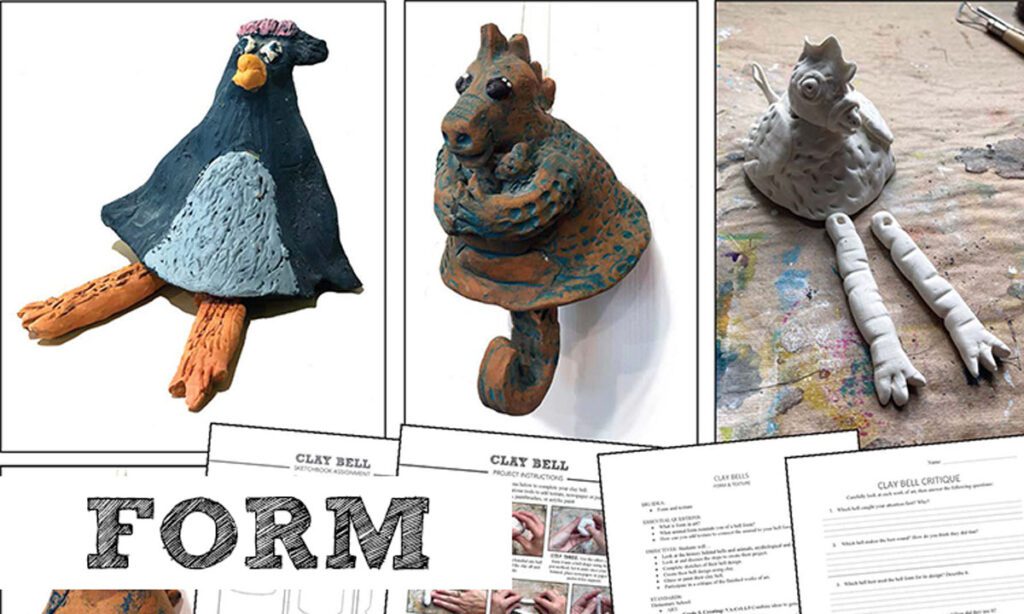
I don’t think a middle school art curriculum is complete without at least one sculpture project. Although it’s easy to focus on 2D lessons, they are easier to store and oversee, it’s so important to introduce students to the world of 3D art. With this lesson, students are creating animal-shaped bells. This is a fun, engaging project with an interactive final product. If you don’t have kiln access, don’t stress! Use air-dry clay and paint. Check this project out on my TPT.
TEXTURE
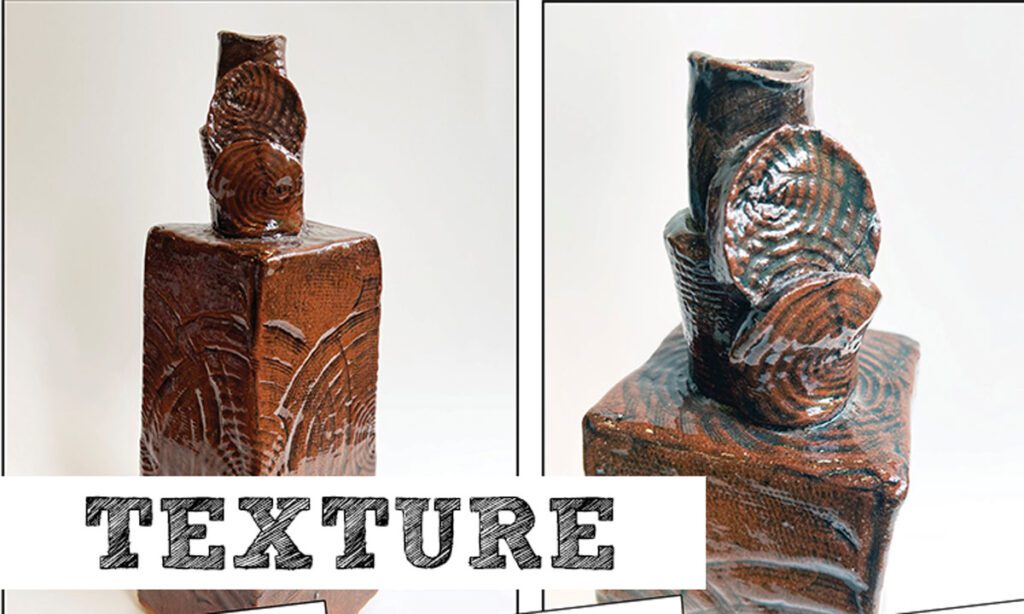
As a follow-up to creating animal bells, students learn about building vessels. Using clay slabs they add texture by pressing objects into the surface of the clay. The slabs are then put together to create a hollow form. This project creates beautiful, displayable sculptures. Check it out on my TPT.
BALANCE

Following sculpture projects, students turn back to 2D by creating mixed media works of art. Balance is the principle of design they focus on as they create a collage of found images. Students then redraw the collage, using cubism as inspiration, adding charcoal, paint, ink, and other materials. This project allows students to experiment with composition and supplies. Check it out on my TPT here or website here.
UNITY

This fun, one-day art activity creates successful results no matter what. Unity is the focus as students turn printed images into tape transfers. These semi-transparent images are then layered over a collage base to create a unique, mixed-media work of art. Check it out on my TPT here or website shop here.
Middle School Art Curriculum Wrap-Up
The final projects of my middle school art curriculum don’t focus on single elements of art and principles of design, but instead task students with harmoniously bringing them all together. First, students explore the world of graphic design and digital art by redesigning a movie poster using the free, online program, Canva. This project is fun and focuses on current topics that interest students (check it out on my TPT or on my website). Next, students further explore collage and mixed media by creating mini works of art to trade. Artist trading cards are always a hit with middle schoolers, this project is a must-try (Check it out on my TPT and on my website). Last, but not least students redraw the still life from day one and bask in the glory of their growth as an artist.
When you design a middle school art curriculum it’s all about scaffolding. You don’t want to throw students into the deep end without them understanding or mastering a technique. In middle school, you need to build confidence for students to enjoy a project and be ready to move to the next step. Start with smaller activities and basics of art with drawing, build to color, test out sculpture, and end with mixed media bringing all the techniques together.
Are you looking for ideas to create an elementary art curriculum? Check out my blog post here.
I hope you have ideas for your next art class and feel more confident in how to scaffold lessons. Please reach out with any questions or comments! Don’t forget to follow me on Instagram and TikTok for weekly visual journal demos and other project ideas. Subscribe here to get freebies, project tutorials, and more straight to your inbox. Until next time!
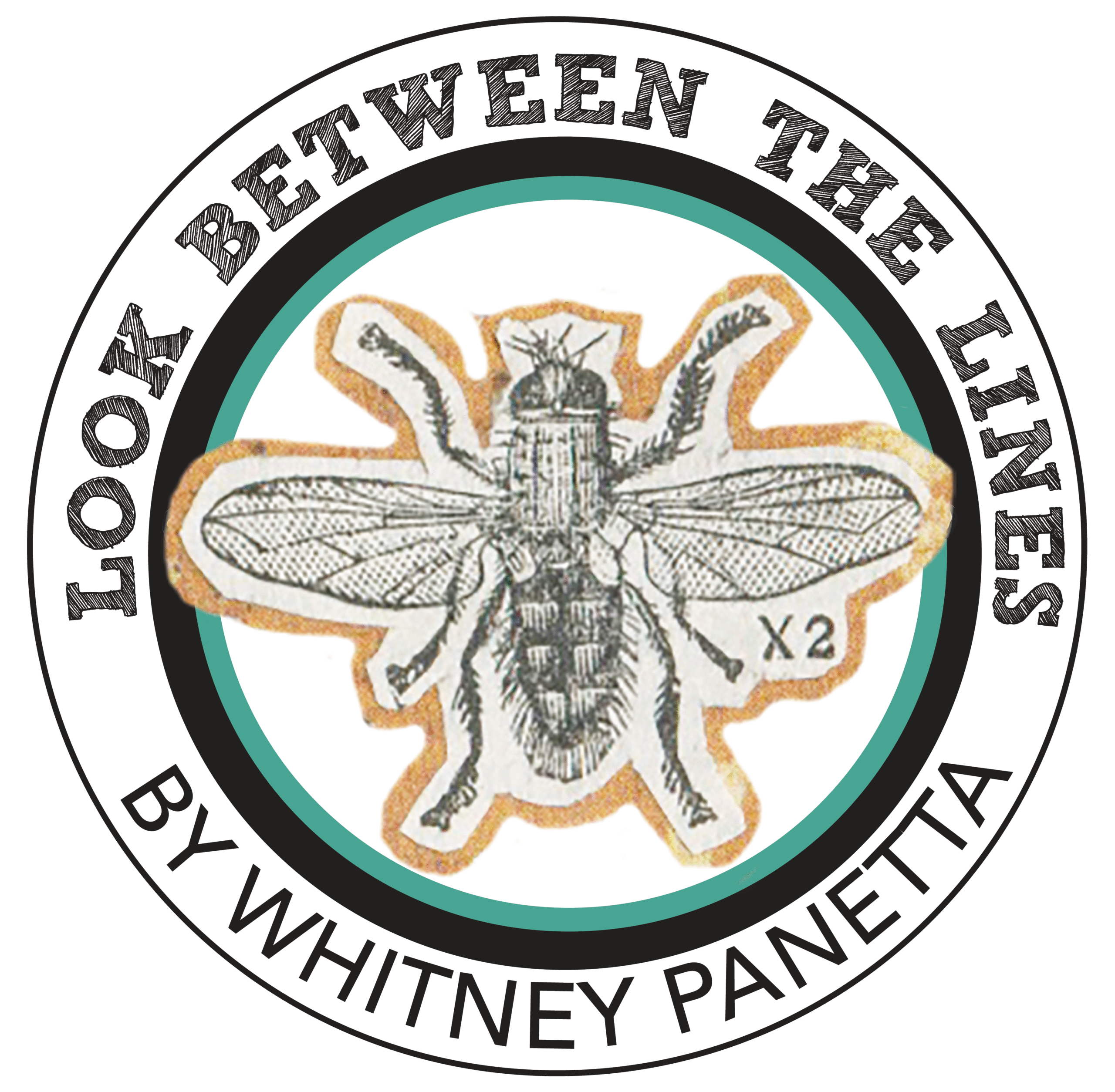
Thanks
Glad you enjoyed it! I hope it helps!
Hi Whitney! I am teaching middle school – Painting and Drawing 1 & 2 combined this year for the first time. I purchased your middle school art bundle for all year/semester/quarter. I was planning on teaching same lesson/concept to all 1 & 2 levels and then provide extensions. My principal (who as an art teacher) said that she always taught two different lessons and projects. That seems a lot. What would you advise?
Hi, Amanda!
I have also taught different lessons in every class, however, since it’s your first year you could teach the same projects across the board then plan to change the lessons in your Painint/Drawing 2 class next year so they aren’t repeating the same projects. If you feel like you need to start the year with different projects between classes I recommend this pack for your Drawing/painting 2 class: https://lookbetweenthelines.com/product/high-school-art-curriculum/ You could ask your principal to help fund this curriculum since they are pushing you to teach different projects.
Let me know if you have any follow-up questions!
Whitney
Hello, 3rd year art teacher here! I have been creating great projects for my middle schoolers, but as I advance in my teaching skills, I am noticing there isn’t much connection through our lessons. I am looking for advice on how to structure a curriculum so that it goes from beginning art to intermediate art the following year, and then to advanced. For example we use perspective to create the cover of our portfolios. Beginning art does 1 point perspective, intermediate does 2 point perspective, and advanced does 3 point perspective. All 3 levels learn this at the same time and it is easy because we are all on the same topic, but I’m advancing their skills. Any advice on how I could do this all year long, but with elements and principles?
Hi, Haley! I think we’ve all struggled with sequencing courses and lessons to make sure everything builds. The way you have perspective scaffolding is great! I think you need to break down the other techniques and teach them similarly with the elements/principles as supporting structure to the curriculum. Since you have intermediate and advance classes building off of your intro middle school class you can look at the projects you intend to teach and make sure there aren’t any holes. You might want to check out my intro high school curriculum to see a good example on how to build on techniques across an intro class, this sounds like it would align better with how you teach your middle schoolers. You can read about it here: https://lookbetweenthelines.com/creating-an-introduction-to-art-curriculum/?